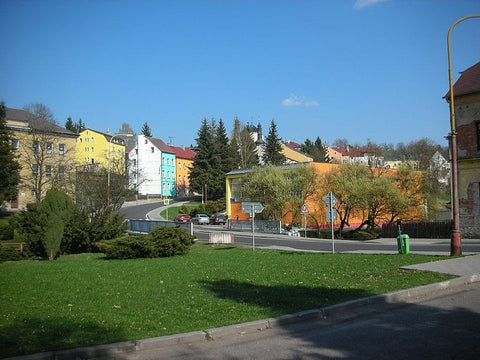A small and very beautiful town called Luby, located on the western border of the Czech Republic, with a population of only 2,100 people, until 1946 was known as Schönbach, which means "Beautiful stream" in German. The German name is due to the fact that until 1918 Bohemia was part of the Austro-Hungarian Empire. Schönbach or Luby has been well known for its violin-making industry, and it was once dubbed the "Austrian Cremona".

The first manufacturers of musical instruments settled in Luby in the first half of the 17th century. The oldest surviving instrument from this region is the viola by Johann Adam Pöpel, dated 1664.
JAPöpel was the first known violin maker in this region and the founder of the Guild of Violinists in Markneukirchen, a German town located next to Schönbach, where he moved with 11 other luthiers. That was the time when Schönbach flourished as a center of violin making.
After the fall of the empire, the production of stringed instruments in Schönbach reached incredible proportions. In 1929, the number of violin makers and apprentices in this tiny town numbered 1,500! The total production volume at that time was about 150,000 pieces of instruments!

After the Second World War, based on the decision of the victorious powers, the majority of the German population, including violin makers, had to move to Germany, where they established their new workshops. Schönbach was renamed Luby.
In 1948, when the Communists came to power, production was gradually nationalized and eventually unified under the banner of a large state-owned enterprise called Cremona, which was renamed Strunal after the fall of the regime, when the production began to be privatized, and in addition to Strunal, several small companies were established, such as Akord Kvint and Ars Music. The result is the redistribution of production into mass and high-quality and separate development of these two different activities.
 This is a good example of mass production. The violin is designed for students of advanced level. It is produced in great quantity and, at the same time, it is an instrument of high quality, just because they can't make bad in Luby, where the tradition of making stringed instruments has been accumulating for centuries!
This is a good example of mass production. The violin is designed for students of advanced level. It is produced in great quantity and, at the same time, it is an instrument of high quality, just because they can't make bad in Luby, where the tradition of making stringed instruments has been accumulating for centuries!
The Harald Lorenz HL3 Violin is hand-made in Luby, in the workshop of Akord Kvint, and is crafted under the direct supervision of Master Luthier Harald Lorenz. This instrument will satisfy an advanced player, even a professional orchestra violinist. It is made with a fully solid, well flamed maple, selected spruce top, spirit hand varnish, brown shaded antiqued finish, ebony fingerboard and pegs, Wittner Ultra tailpiece, Despiau ‘C’ bridge, Thomastik-Infeld Dominant Strings.

ARS Music Intermediate Handcrafted Cello is made in the same Akord Kvint workshop.
Fully solid, flamed European tone wood in a chestnut brown finish. It has an ebony fingerboard, pegs with Parisian eye, and Weidler endpin, with a Wittner Ultra tailpiece, and Thomastik-Infeld Spirocore strings.

